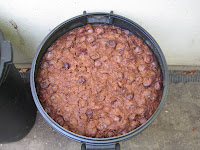 The mixture has not changed much in the past few days. The smell has not changed either.
The mixture has not changed much in the past few days. The smell has not changed either.
Wednesday, July 30, 2008
Friday, July 25, 2008
Thursday, July 24, 2008
Wednesday, July 23, 2008
Tuesday, July 22, 2008
Monday, July 21, 2008
Sunday, July 20, 2008
Saturday, July 19, 2008
Day twelve.
Friday, July 18, 2008
Day eleven.
Thursday, July 17, 2008
San Francisco Chronicle
I found an interesting and very well written article on home distilling. It is somewhat informative about the legal aspects of this activity in certain countries.
Day ten.
Wednesday, July 16, 2008
Day nine.
Tuesday, July 15, 2008
Day eight.
Monday, July 14, 2008
Day seven.
Sunday, July 13, 2008
Day six.
Saturday, July 12, 2008
Day five.
Friday, July 11, 2008
Day four.
Thursday, July 10, 2008
Day three.
Wednesday, July 9, 2008
Day two.
Tuesday, July 8, 2008
Day one.

 The fermentation process starts almost right away. It is expected to take 2 to 3 weeks. Initially most of the plums are on top of the container. Some of them look in pretty bad shape. That is to be expected. Here is how my plums look after one day sitting in water and a little sugar. It is very important that you stir the mixture at least once a day. The container should also be kept loosely closed.
The fermentation process starts almost right away. It is expected to take 2 to 3 weeks. Initially most of the plums are on top of the container. Some of them look in pretty bad shape. That is to be expected. Here is how my plums look after one day sitting in water and a little sugar. It is very important that you stir the mixture at least once a day. The container should also be kept loosely closed.
Monday, July 7, 2008
Start up the process.
 You are now about to do one of the key parts in the making Rakia the Bulgarian style. You will have to add water and perhaps some sugar to start the fermentation. Now it will be a good time to call you uncle in Bulgaria to get the family recipe. The recipe I got is the following. Add one kilogram sugar for each 4 liters of water, at the end of the process this will produce about 400ml of good Rakia. Use your judgment how much liquid you are going to add, but you should have all your plums covered. Put the top on the container. Now you have to wait.
You are now about to do one of the key parts in the making Rakia the Bulgarian style. You will have to add water and perhaps some sugar to start the fermentation. Now it will be a good time to call you uncle in Bulgaria to get the family recipe. The recipe I got is the following. Add one kilogram sugar for each 4 liters of water, at the end of the process this will produce about 400ml of good Rakia. Use your judgment how much liquid you are going to add, but you should have all your plums covered. Put the top on the container. Now you have to wait.
Collect the goods.
Pickup all plums into the carefully washed container. Make sure you collect all plums, including the ones that are all smashed, rotten, or covered with fungus. Make sure you place the container on a shady place, preferably away from the neighbors.
Get down to business.


Once you have the barrels, you are ready to pick the crop. This is best done by shaking the plum tree violently, and then collecting the plums from the ground. You can also use a long stick to get the hard to reach plums. Remember, "There should be lots of material!". Do not worry about ruining the fruit ... this is just the beginning for it.
Sunday, July 6, 2008
Barrel(s).
Saturday, July 5, 2008
Rakia fans across the web.
I found this somewhat informative and very colorful blog about Bulgarian rakia traditions and customs. It is a pretty good read. http://www.therakiasite.com/
First thing first.
 If you are in the business of making Rakia, you'll need to first produce a reasonable quantity of well riped plums. My recipe does not exactly specify neither the quantity nor the quality of the plums. One of my sources, though, claims that "there should be lots of material" (б.а. преведено от: "Трябва да има материал!"). Preferably, you are going to have a plum tree in your backyard. If not, you can buy plums from the local supermarket; most stores in the US sell them for about 4 dollars per kilogram.
If you are in the business of making Rakia, you'll need to first produce a reasonable quantity of well riped plums. My recipe does not exactly specify neither the quantity nor the quality of the plums. One of my sources, though, claims that "there should be lots of material" (б.а. преведено от: "Трябва да има материал!"). Preferably, you are going to have a plum tree in your backyard. If not, you can buy plums from the local supermarket; most stores in the US sell them for about 4 dollars per kilogram.
Subscribe to:
Posts (Atom)




























